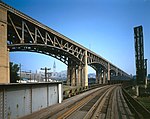Sokolowski's University Inn
1923 establishments in OhioAmerica's Classics winnersCulture of ClevelandDefunct restaurants in OhioEastern European restaurants ... and 7 more
European restaurants in OhioOhio stubsPolish restaurantsRestaurants disestablished during the COVID-19 pandemicRestaurants disestablished in 2020Restaurants established in 1923Tremont, Cleveland

Sokolowski's University Inn was a restaurant in Cleveland, Ohio. It was recognized as one of America's Classics by the James Beard Foundation.
Excerpt from the Wikipedia article Sokolowski's University Inn (License: CC BY-SA 3.0, Authors, Images).Sokolowski's University Inn
West 13th Place, Cleveland
Geographical coordinates (GPS) Address Nearby Places Show on map
Geographical coordinates (GPS)
| Latitude | Longitude |
|---|---|
| N 41.484722222222 ° | E -81.690138888889 ° |
Address
West 13th Place
West 13th Place
44113 Cleveland
Ohio, United States
Open on Google Maps








